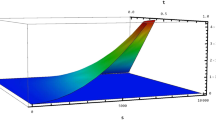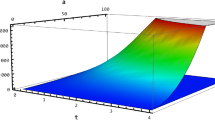Abstract
A new approach to duality in fractional programs is described. The techniques used are based on the theory of pseudoduality. The results are generalized to include mathematical programs with quotients and products of finitely many functionals. The duals of the linear and quadratic cases are explicitly calculated, demonstrating the power of pseudo-duality theory.
Similar content being viewed by others
References
Charnes, A., andCooper, W.,Programming with Linear Fractional Functions, Naval Research Logistics Quarterly, Vol. 9, pp. 181–196, 1962.
Schaible, S.,Analyse und Anwendungen won Quotienprogrammen, Mathematical Systems in Economics, Edited by W. Eichhorn and R. Henn, Verlag Anton Hain, Meisenheim, West Germany, 1978.
Schaible, S.,Duality in Fractional Programming: A Unified Approach, Operations Research, Vol. 24, pp. 452–461, 1976.
Passy, U., andYutav, S.,Pseudo-Duality in Mathematical Programming, part A, Unconstrained and Equality Constraints, Technion, Haifa, Israel, Operations Research, Statistics, and Economics, Mimeograph Series No. 208, 1978.
Passy, U., andYutav, S.,Pseudo-Duality Inequality Constraints: Extended Geometric Programs, Technion, Haifa, Israel, Operations Research, Statistics, and Economics, Mimeograph Series No. 210, 1978.
Passy, U., andYutav, S.,Pseudo-Duality and Saddle Points, Technion, Haifa, Israel, Operations Research, Statistics, and Economics, Mimeograph Series No. 214, 1978.
Schaible, S.,Parameter-Free Convex Equivalent and Dual Programs of Fractional Programming Problems, Zeitschrift für Operations Research, Vol. 18, pp. 187–196, 1974.
Schaible, S.,Quasi-Concave, Strictly Quasi-Concave, and Pseudo-Concave Functions, Methods of Operations Research, Edited by R. Henn, H. P. Kunzi, and H. Schubert, Verlag Anton Hain, Meisenheim, West Germany, 1972.
Passy, U.,Duality and Pseudo-Duality in Mathematical Programs with Quotients and Products of Finitely Many Functionals, Technion, Haifa, Israel, Operations Research, Statistics, and Economics, Mimeograph Series No. 218, 1978.
Klinger, A., andMangasarian, O. L.,Logarithmic Convexity and Geometric Programming, Journal of Mathematical Analysis and Applications, Vol. 24, pp. 388–408, 1968.
Author information
Authors and Affiliations
Additional information
Communicated by M. Avriel
The author wishes to thank Prof. S. Schaible for his helpful comments. In discussions with Prof. Schaible, it was found that the duals for the linear and the quadratic cases are identical with those derived in Ref. 3.
Rights and permissions
About this article
Cite this article
Passy, U. Pseudo-duality in mathematical programs with quotients and products. J Optim Theory Appl 33, 349–374 (1981). https://doi.org/10.1007/BF00935249
Issue Date:
DOI: https://doi.org/10.1007/BF00935249




